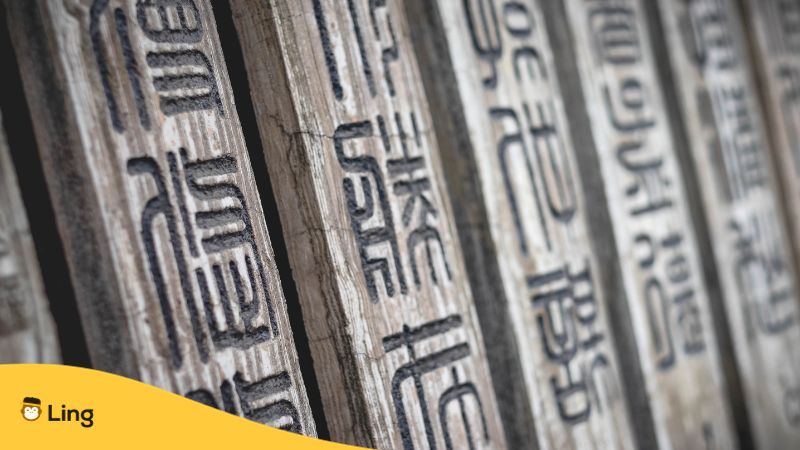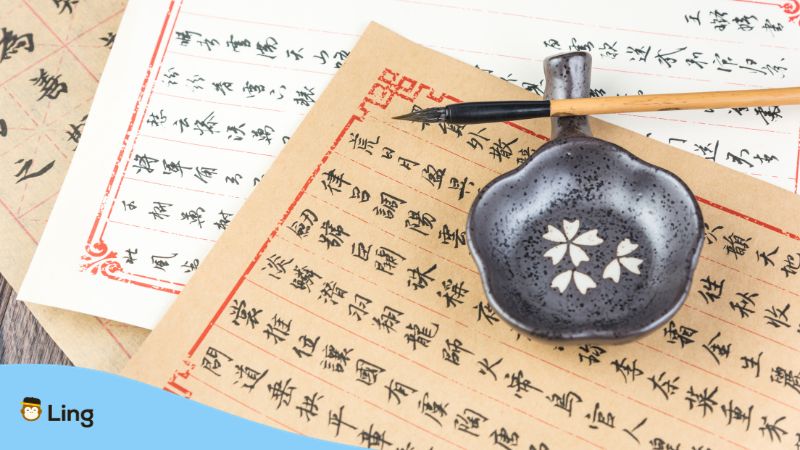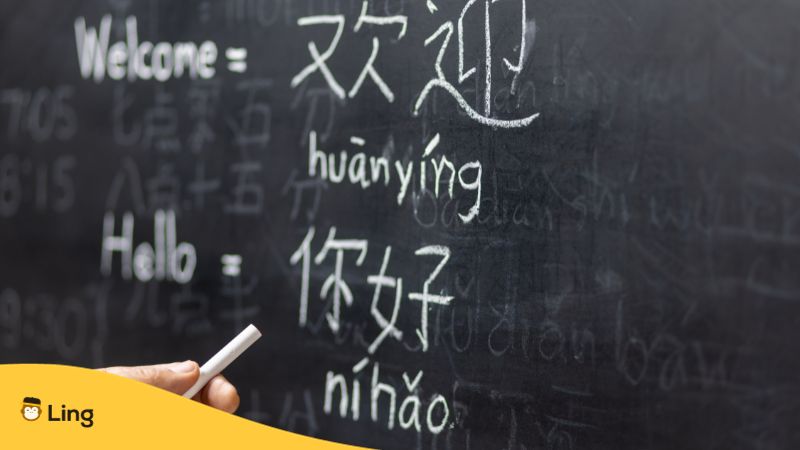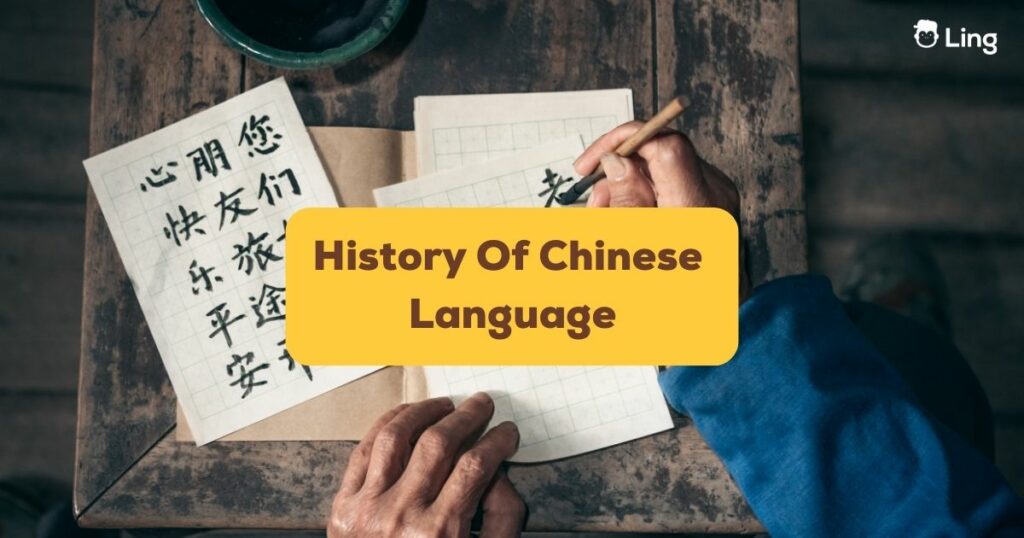Chinese is a fascinating language. It’s filled with unique characters, varying tones, and even complete thoughts packed into a single syllable. But did you know that the history of Chinese language is as rich and complex as its grammar?
In this post, we’ll peel back the layers of history to uncover the story of the Chinese language, a timeless tale that spans millennia. From ancient etchings on oracle bones to modern calligraphy on the bustling streets of Beijing, Chinese has transformed and evolved in ways that will make you appreciate it even more.
Are we set? Let’s go back in time and unravel the captivating chronicles of the Chinese language.
The Beginnings: Oracle-Bone Script
Let’s take a step back, all the way back, to sift through the layers of time and unravel the origins of the Chinese language. It’s like linguistic archeology, and it will be a captivating journey!
Back in the day (we’re talking about 3,500 years ago), the archaic Chinese language started to come alive during the Shang dynasty. Do you know what they used to write? It was something super cool called the Oracle bone script.
No, it wasn’t written on paper, as they didn’t have that yet. Rather, these were inscriptions etched onto – believe it or not – animal bones and turtle shells. These oracle bones are extremely important to us now because they’re like an ancient telegram service offering a glimpse into the past. They reveal how people lived, their beliefs, and how the ancient Chinese language evolved.
The Evolution: Seal Script And Clerical Script
As the years passed, the old Chinese script evolved into the Seal script around the end of the Zhou Dynasty. Reflecting an artistic style, Seal script is known for its pictographic quality, with characters beautifully represented in rounded, stylized shapes.
The next stage in this evolution is the Clerical script, born during the Han Dynasty. This version features a modified style that is easier to write and read. The slender strokes and stylized figures of the Seal script gave way to a more square and regular form, a significant step towards the Standard script.

The Revolution: The Birth Of Modern Chinese Scripts
Towards the end of the Qing Dynasty, around the 19th and 20th centuries, the Chinese language passed through an era of massive transformation. Here, we saw the creation of the standard script, a predecessor to the Modern Chinese Script. Also, the printing press’s invention during the Tang Dynasty had an incredible effect, by spreading literacy and popularizing the written Chinese language.
Initially, there were many dialects in China, making communication somewhat difficult. The fall of the Qing dynasty in 1911 and the rise of the Republic of China pushed for a unified language, as they believed it would strengthen national identity and boost modernization. Another significant event was the May Fourth Movement in 1919, where intellectuals and students protested for wide-ranging reforms. This movement called for a break from traditional Chinese culture, and part of this push was to simplify and reshape the Chinese written language, making it more accessible to the general public.
With these changes underway, the Chinese language took a new direction, evolving from Classical Chinese to the more recognizable Mandarin.
Discovering Mandarin
In the early 20th century, China decided to standardize its language to create one cohesive spoken and written form. That’s when Modern Chinese, or Mandarin, was born. Officially known as Putonghua (普通话), meaning “common speech,” Mandarin quickly gained popularity and spread across the country.
Mandarin was actually derived from the dialect of Beijing, China’s capital. This dialect was considered “standard” due to its clarity and simplicity. As a result, the government decided to adopt it and promote Beijing Mandarin as the country’s official national language, making it easier for people from different regions to communicate.
From there, Mandarin rapidly expanded, reaching beyond Chinese borders. With its immense population and economic growth, China’s influence grew, making Mandarin an essential language for global communication.

Pinyin System And Simplified Chinese
Now, let’s journey into the period when the Chinese native language went through some big changes. This delightful transformation is all about the Pinyin system and Simplified Chinese.
What on Earth is this Pinyin, you ask? Pinyin is a brilliant system that uses the Roman alphabet to phonetically transcribe Mandarin. In plain English? It helps you to pronounce Chinese words using letters you’re familiar with. Imagine trying to pronounce the word 冰淇淋 (which means ice cream). It’s tough, right? But in Pinyin, it transforms into “bīng qí lín”. Sounds a lot easier, doesn’t it? This system was introduced by the Chinese government in the 1950s and helped make Mandarin more accessible to learners.
Now, onto Simplified Chinese. Simplified Chinese, or Middle Chinese, is pretty much what it sounds like, a simpler version of traditional Chinese characters. To give you an idea – the traditional character for “dragon” is “龍,” but in Simplified Chinese, it’s “龙” – looks much less intimidating, doesn’t it? The transformation of characters like these has made it easier to read and write the language.
By introducing the Pinyin system and Simplified Chinese, China aimed to increase literacy and make the language more approachable. This is the ultimate example of modernizing a spoken language without losing its historical roots.

Dialects Of The Chinese Language
When diving into the rich and fascinating Chinese language history, one of the most striking aspects is the diversity of dialects. Each of these Chinese variations has distinct characteristics and histories, all its own. So, let’s explore these linguistic wonders one by one, shall we?
Mandarin
First, we already know about Mandarin. It is the most common language in Mainland China, originating in North and Southwestern China. Today, it basks in the glory of being the most widely spoken Chinese dialect, both within the country and globally, thanks to its status as the official language of China. If you’ve ever taken a Chinese language class overseas, Mandarin is likely the version you’ve studied.
Wu
Next up is Wu, the second most significant dialect. Wu stands its ground in Eastern China, primarily in the Zhejiang province and the city of Shanghai. Wu dialect presents quite a striking variation from Mandarin and proudly stands out with its unique tonal differences and vocabulary. For music lovers, it’s fascinating to note that the famous Shaoxing opera is performed in this dialect.
Yue
Further down the linguistic path, we come across Yue, commonly known as Cantonese. This dialect hails from the vibrant province of Guangdong. If your mental map is hazy, just think of the magnificent city of Hong Kong, where Cantonese reigns supreme. Yue is unique in its own way, with six tones, as opposed to the four in Mandarin!
Jin
We cannot embark on a Chinese dialects tour without a stop at the Jin dialect. Famously associated with the Shanxi province in Northern China, Jin shares common roots with Mandarin yet boasts its unique pronunciation and grammar.
Min
Venturing southwards, we find Min. Have you heard of the city of Fujian? That’s where Min traces back its roots. Intriguingly, Min is not just a single variation but a cluster of dialects flaunting several different, sometimes mutually unintelligible, sub-dialects across various regions of Fujian.
Xiang
Moving on, meet Xiang, the dialect connected with the province of Hunan. You might remember Hunan as it’s where the world-renowned spicy cuisine comes from! Xiang dialect, while largely similar to Mandarin, still manages to keep its distinct characteristics intact.
Hakka
Last but not least is Hakka, predominantly spoken by the Hakka people in various parts of Southern China, Taiwan, and Hong Kong. This dialect has always been a significant part of the Chinese linguistic culture.
Now, remember I’d talked about the geographical spread and influence of Chinese dialects? Well, Chinese immigration throughout history has carried these dialects to various corners of the globe, from Southeast Asia to North America. Mandarin, Yue (Cantonese), Wu, and Min, in particular, have made substantial marks on international communities. The Chinese language, with all its dialects, truly is a testament to the rich and diverse cultural landscape of China.
History Of Chinese Language: The Digital Age
We’ve all been fascinated by the rich history and complexity of the Chinese language, right? But how is this age-old language faring in today’s digital world? Well, pretty spectacularly, we might say!
Once upon a time, mastering Chinese meant countless hours with physical dictionaries, flashcards, and textbooks. You’d immerse yourself in complicated characters and prepare for mind-bending grammar. Well, things have changed.
Can you imagine a world where you can learn Chinese, one of the most difficult languages in the world, right from your comfy couch? Thanks to the surge of language learning apps, it’s possible now. Remember the times when mastering Chinese felt like an uphill battle? Today, fantastical apps like the Ling app have totally revolutionized the learning process.
In today’s digital world, the Chinese language has not just survived but thrived beautifully. It transcended borders and reached millions of eager learners, all thanks to advancing technology. Now, anybody can access and master Chinese, one of the world’s most spoken languages, right at their fingertips.
Learn Chinese With The Ling App
Don’t let language barriers hold you back any longer! Dive into a world full of linguistic wonders with the Ling app. Ready to learn a new language at your own pace? Interactive games, engaging quizzes, and practical lessons are just a tap away. Click to join over 1 million users who are already broadening their horizons with Ling. Whether you’re dreaming of ordering a meal in Italian or negotiating a deal in Mandarin, the Ling app has got you covered.
Download the app on the App Store or Play Store today!


































































